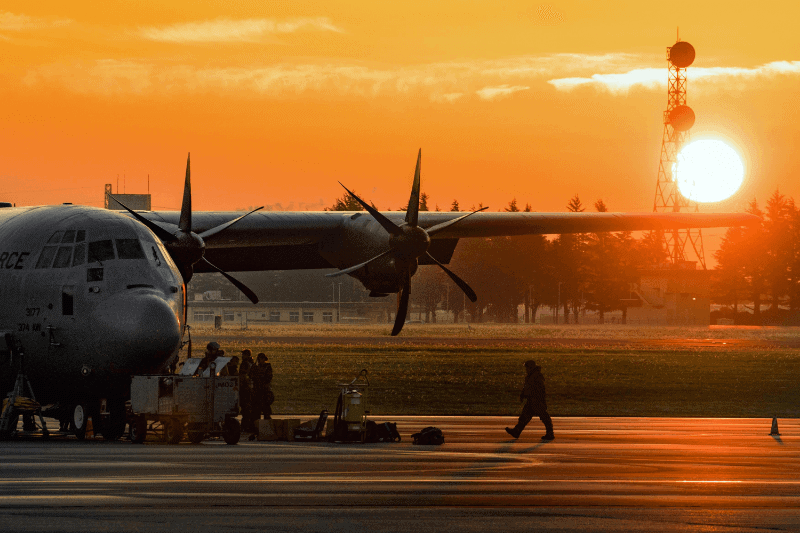
The Internet is full of information about Space-A military flights, and it’s often overwhelming to decide what to read first. If you’re new to Space-A travel, start by learning the basics and how to read the 72-hour flight schedules.
Once you understand the process, all Space-A travelers should learn a few tips and strategies to boost their chances of success.
To help you bring all that information together, here are some do’s and don’ts to know when flying Space-A.
1. DO your research.
If you haven’t read the articles linked above, start there, and keep reading. Space-Available travel is a process, and like everything in the military, it comes with rules and regulations that you must understand and follow. Your travels will go a lot smoother if you’ve done your homework.
DON’T go in blind.
2. DO use military Space-A for leisure travel when you have time and flexibility.
Your best friend’s wedding, a funeral, a family event: those are not the right times to fly Space-A. Space-A is never a good option when you need to be somewhere by a certain time, because it’s too unpredictable.
DON’T use Space-A for emergencies or important events.
3. DO Make a backup plan (or three) when flying Space-A.
Your backup plan could include catching a hop to a different destination and renting a car or taking a roundabout way to your target destination by patching together different Space-A flights. Your last resort is to fly commercial, so make sure you have enough money to pay for tickets.
DON’T fly Space-A unless you have funds to pay for commercial airfare.
4. DO ensure that all of your post-flight travel plans are flexible or refundable.
When flying Space-A, you shouldn’t book a hotel, tour, cruise, or anything else you can’t cancel if don’t arrive at your destination on time.
DON’T make non-refundable reservations based on your expected Space-A flight.
5. DO avoid the busiest travel times to increase your chances of getting a seat.
The summer PCS season and the winter holidays are the worst times to fly Space-A. Spring break isn’t good either, because it’s generally only 1 week. Yes, it’s possible you will get a seat, especially if you are Cat 3 (active duty on leave). But do you really want to risk blowing your spring vacation sitting in the passenger terminal?
DON’T fly Space-A, especially OCONUS, during school breaks unless you’re prepared to buy last-minute commercial tickets to save your vacation.
6. DO stay in the terminal if you are selected for a flight.
Return your rental car and make that final commissary run before Roll Call. You will lose your seat if you’re not there when the passenger terminal staff finish manifesting passengers.
DON’T leave the terminal between Roll Call and baggage check.
7. DO stick around the terminal a while longer . . .
Even if Roll Call ends and you didn’t make the cut, there’s always a chance that more seats will open up. Most other Space-A passengers will leave if they don’t get a seat. If you’re the only one left when they release more seats, you just got lucky! Let the passenger terminal staff know that you’re still waiting.
DON’T leave the terminal before the plane departs.
8. DO treat passenger terminal staff with kindness.
Space-A flights – better known as military missions – are changed, canceled, and delayed regularly. All of these things are beyond the control of the terminal staff. Don’t shoot the messenger when you learn that you won’t get a seat on the flight you wanted (or that you have been bumped for a family of space-required passengers).
DON’T blame the passenger terminal staff.
9. DO remember that Space-A is a privilege.
Our job as Space-A passengers is to be as little burden to the military flight crew as possible. Dress in layers so you can adjust accordingly if the plane is too hot or too cold, and bring plenty of your own snacks and water in case there are no boxed meals available. (Here’s our Space-A packing list.)
DON’T be “that passenger” who complains or makes life difficult for the flight crew.
10. DO follow host country immigration procedures when flying to or from a foreign country.
Some military passenger terminals overseas, including NAS Sigonella and bases in Japan, require Space-A passengers to go to an immigration office off base to obtain the required passport stamp.
Make sure you follow the required process. It may take extra time and in some cases, extra money for taxis. As noted in #9, Space-A is a privilege, and it is not the responsibility of the passenger terminal staff or the host nation to make free flights more convenient for Space-A passengers.
DON’T skip any required steps in the immigration process.
11. DO keep children under control.
No matter how much open space is on that C-17, keep in mind that you’re on a military mission. It’s not safe for kids to run around, and it’s not the crew’s responsibility to ensure that kids aren’t getting into trouble or bothering other passengers.
DON’T let the kids run wild.
12. DO approach your Space-A journey with a positive attitude.
Along the way, you will meet other travelers who remind you how helpful and supportive the military community can be. Hitching a ride with a military mission is a privilege and, for dependents who have never flown in a military aircraft, a very unique experience. If you think of your journey in this way, you will feel better-prepared to handle any parts of the process that don’t go as planned.
DON’T forget that Space-A is an adventure!
A version of this article was first published on PCSgrades.

Space A is very easy to use. Talk to any terminal staff and ask all the questions that yoy may have. They are very knowledgeable on the process.You do need flexable time for all your travels. Don’t be in a rush. As the say in Hawaii hang loose.
Hi Chuck,
I think that’s great advice from Hawaii!